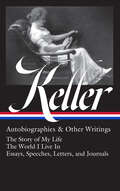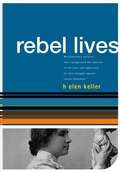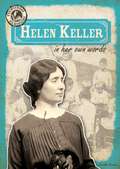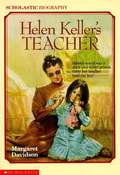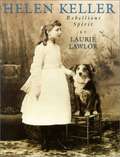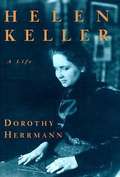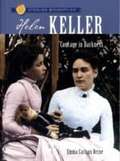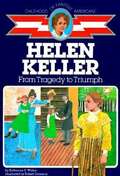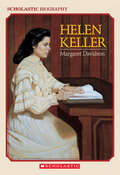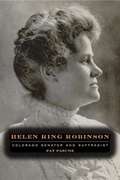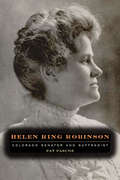- Table View
- List View
Helen Keller (LOA #378): The Story of My Life / The World I Live In / Essays, Speeches, Letters, and Jour nals
by Helen KellerIn her own words, the legendary American icon who overcame adversity to become a brilliant writer and powerful advocate for the disabled: The Story of My Life, The World I Live In, plus a dozen revealing personal letters, public speeches, essays, and moreHere, in a deluxe hardcover edition, is the inspiring story of an American icon—&“the greatest woman of our age,&” as Winston Churchill put it—in her own words.The Story of My Life (1903), published just before she became the first deaf-blind college graduate in the United States, brought Helen Keller worldwide fame, and has remained a touchstone for generations. Recounting her astonishing relationship with her teacher, Annie Sullivan, "the Miracle Worker," it offers still-vivid testimony of the transformative power of love and faith in overcoming adversity. Keller&’s underappreciated literary artistry and philosophical acumen are especially evident in the personal essays that make up The World I Live In (1908): exploring her own &“disability,&” she reflects profoundly on language, thinking, dreams, belief, and the relations between the senses. Also included are more than a dozen letters, speeches, essays, and other works—most of them from out-of-print, uncollected, or previously unpublished sources—charting more than 50 years of Keller&’s exemplary life and career. These pieces reveal her commitments to women&’s rights, workers&’ rights, racial justice, and peace, as well as her advocacy for the disabled. Kim E. Nielsen, Keller&’s biographer and the author of A Disability History of the United States, introduces the volume, which includes a 16-page portfolio of photographs and a newly researched chronology of Keller&’s life, along with authoritative notes and an index.
Helen Keller (National Geographic Kids Readers)
by Kitson JazynkaReaders will be inspired by the amazing story of Helen Keller in this informative biography. They will learn all about her life, her achievements, and the challenges she faced along the way. The Level 2 text provides accessible, yet wide-ranging, information for independent readers.
Helen Keller (Rebel Lives)
by Helen Keller John Davis<P>A different portrayal of Keller, who is usually remembered for her work aiding blind and deaf-blind people. <P>Deaf and blind herself from the age of 19 months, Keller did indeed devote her adult life to helping those similarly afflicted - she was also a crusading Socialist, championing the poor and oppressed from all walks of life and leading a fight against the less obvious evil of social blindness. <P>John Davis has collected her political writing and speeches, including her arguments for women's suffrage, her opposition to the world wars and support for Eugene V. Debs.
Helen Keller and the Big Storm
by Patricia LakinIt is a beautiful summer afternoon. Helen and her teacher have climbed a tree. While Helen waits for her teacher to get some snacks, a thunder storm strikes!
Helen Keller in Her Own Words
by Caroline KennonThough Helen Keller became deaf and blind after a childhood illness in 1882, she grew up to be a renowned author, activist, and speaker. With the help of her teacher, Anne Sullivan, Keller overcame major obstacles in her life and used them to become an advocate for those experiencing discrimination and hardship. This inspiring biography uses Keller's own words as a primary source, so that readers can better know and understand this amazing woman and leader.
Helen Keller's Best Friend Belle
by Jennifer Thermes Holly M. BarryMany know the story of Helen Keller's journey to learn to communicate. And many have heard of Anne Sullivan, the brilliant teacher who helped Helen understand. But have you ever heard about Belle the dog? In this new picture book biography of Helen Keller's early life, readers are introduced to her beloved dog, Belle, who is with Helen every step of the way!
Helen Keller's Teacher
by Margaret DavidsonFor twenty- year- old Annie Sullivan, life had been one hardship after another. All alone and half blind, she grew up in a poorhouse with only her pride and determination to sustain her. Even though the odds were against her, she would never allow her handicaps to defeat her. That is until she meets Helen Keller. The world is a dark and silent prison for little Helen. She cannot see or hear or speak. To Annie falls the incredible task of teaching Helen how to read, to write - to live a full life. Is Annie up to this incredible challenge? Can she dare to dream of accomplishing a miracle? This is the true story of Annie's and Helen's courage and determination to succeed.
Helen Keller, Rebellious Spirit: The Life and Times of Helen Keller
by Laurie LawlorRecounting her mischievous nature, her little known romance, and her trials with her teacher and the public, this biography sheds new light on this extraordinary woman.
Helen Keller: A Life
by Dorothy HerrmannA comprehensive biography of Helen Keller, focusing not only on her disabilities and challenges and how she overcame them or made them moot, but also on her relationships, her work with other challenged and inspirational people, her involvement in the arts as subject and as participant, and her political beliefs and actions.
Helen Keller: A Light for the Blind
by Kathleen V. KudlinskiA biography detailing Helen Keller's adventurous life as she worked tirelessly to lead the way for handicapped people.
Helen Keller: An Inspiring Life (Easy Reader Biographies)
by Carol GhiglieriHelen Keller was deaf and blind, but went on to learn and teach and advocate. Correlate with Guided Reading Levels J. For use with Grades K-2.
Helen Keller: Break Down the Walls (Defining moments Overcoming challenges)
by Margaret FettyThe students will meet a remarkable woman who rose above the challenges of being deaf and blind to become one of the most respected speakers in America. Children will read how Keller worked with her teacher, Anne Sullivan, to learn to communicate when most people in the late 19th century held little hope for the deaf and blind.
Helen Keller: Courage In Darkness
by Emma Carlson Berne Marie HodgeHelen Keller lived in darkness and silence, but she dazzled the world with her accomplishments. Her powerful story lives on in this remarkable biography by Emma Carlson Berne. Find out about: the illness that destroyed young Helen s sight and hearing; her explosive first meeting with her teacher Annie Sullivan; her struggle to become the first blind/deaf student ever awarded a degree from prestigious Radcliffe College; the romance that almost led to marriage and her life as writer, lecturer and world traveller.
Helen Keller: Courage in the Dark (Step into Reading)
by Johanna HurwitzWhen a childhood illness leaves her blind and deaf, Helen Keller's life seems hopeless indeed. But her indomitable will and the help of a devoted teacher empower Helen to triumph over incredible adversity. This amazing true story is finally brought to the beginner reader level.
Helen Keller: Crusader for the Blind and Deaf
by Stewart Graff Polly Anne GraffFrom the age of a year and a half, Helen Keller could not hear. She could not see, and she did not speak. She lived in a dark and lonely world--until Annie Sullivan came to teach her. Annie traced letters and words in Helen's hand, and made Helen realize she could "talk" to people. Eager to make up for lost time, Helen threw herself into her studies. She decided to teach others about the special training deaf and blind children need. Helen traveled all over the globe and raised money to start up schools for deaf and blind children. Her courage and her determination to help others conquer the odds against them earned her the respect and admiration of the world.
Helen Keller: From Tragedy to Triumph
by Katharine E. WilkieFocusing on her childhood years, this biography is about Helen Keller who overcame her handicaps with the help of her teacher Anne Sullivan.
Helen Keller: Scholastic Biography
by Margaret Davidson Wendy WatsonThe best-selling biography of Helen Keller illustrates how, with the commitment and lifelong friendship of Anne Sullivan, Helen learned to talk, read, and eventually graduate from college with honors.
Helen Keller: The Story of My Life
by Amy Jolin AngeloWith its high-interest adaptations of classic literature and plays, this series inspires reading success and further exploration for all students. These classics are skillfully adapted into concise, softcover books of 80-136 pages. Each retains the integrity and tone of the original book. Interest Level: 5-12 Reading Level: 3-4
Helen Keller: The World at Her Fingertips (I Can Read Level 2)
by Sarah AlbeeLearn about the inspiring life of Helen Keller in this early reader biography.When Helen Keller was a baby, she became sick and lost her ability to see and hear. Although many people doubted her ability to persevere, Helen did not let any obstacle stop her from achieving many things in her amazing life.This book covers some of the well-known and inspiring milestones of Keller’s life—it’s a great supplement for book reports on this iconic historical figure. It also covers some of the lesser-known fun facts—did you know that Helen Keller was a long-time dog lover?This biography reader includes a timeline, historical photographs, and information about Braille. Helen Keller: The World at her Fingertips is a Level Two I Can Read, geared for kids who read on their own but still need a little help. Whether shared at home or in a classroom, the engaging stories, longer sentences, and language play of Level Two books are proven to help kids take their next steps toward reading success.
Helen Ring Robinson
by Pat PascoeHelen Ring Robinson was Colorado's first female state senator and only the second in the United States. Serving from 1913 to 1916, she worked for social and economic justice as a champion of women, children, and workers' rights and education during a tumultuous time in the country's history. Her commitment to these causes did not end in the senate; she continued to labor first for world peace and then for the American war effort after her term ended. Helen Ring Robinson is The first book to focus on this important figure in the women's suffrage movement and the 1913, 1914, and 1915 sessions of the Colorado General Assembly. Author Pat Pascoe, herself a former Colorado senator, uses newspapers, legislative materials, Robinson's published writings, and her own expertise as a legislator to craft the only biography of this contradictory and little-known woman. Robinson had complex politics as a suffragist, peace activist, international activist, and strong supporter of the war effort in World War I and a curious personal life with an often long-distance marriage to lawyer Ewing Robinson, yet close relationship with her stepdaughter, Alycon. Pascoe explores both of these worlds, although much of that personal life remains a mystery. This fascinating story will be a worthwhile read to anyone interested in Colorado history, women's history, labor history, or politics.
Helen Ring Robinson: Colorado Senator and Suffragist (Timberline Books)
by Pat PascoeCalling herself "the housewife of the senate," Helen Ring Robinson was Colorado's first female state senator and only the second in the United States. Serving from 1913 to 1917, she worked for social and economic justice as a champion of women, children, and workers' rights and education during a tumultuous time in the country's history. Her commitment to these causes did not end in the senate; she continued to labor first for world peace and then for the American war effort after her term ended. Helen Ring Robinson is the first book to focus on this important figure in the women's suffrage movement and the 1913, 1914, and 1915 sessions of the Colorado General Assembly. Author Pat Pascoe, herself a former Colorado senator, uses newspapers, legislative materials, Robinson's published writings, and her own expertise as a legislator to craft the only biography of this contradictory and little-known woman. Robinson had complex politics as a suffragist, peace activist, international activist, and strong supporter of the war effort in World War I and a curious personal life with an often long-distance marriage to lawyer Ewing Robinson, yet close relationship with her stepdaughter, Alycon. Pascoe explores both of these worlds, although much of that personal life remains a mystery. This fascinating story will be a worthwhile read to anyone interested in Colorado history, women's history, labor history, or politics.
Helen's Big World: The Life of Helen Keller
by Doreen Rappaport Matt TavaresThis picturebook biography is an excellent and accessible introduction for young readers to learn about one of the world's most influential luminaries. With her signature style of prose laced with stirring quotes, Doreen Rappaport brings to life Helen Keller's poignant narrative. Acclaimed illustrator Matt Tavares beautifully captures the dynamism and verve of Helen Keller's life and legacy, making Helen's Big World an unforgettable portrait of a woman whose vision for innovation and progress changed America-and the world-forever.
Helen's Eyes: A Photobiography Of Annie Sullivan, Helen Keller's Teacher
by Marfe Ferguson DelanoThe epic story of Annie Sullivan’s perseverance and triumph in the face of hardship will enthrall readers of every age. This pioneering teacher overcame disability and misfortune before achieving her success as one of the most famous educators of all time. <P><P> This is the inspiring photobiography of Anne Mansfield Sullivan, a woman born into a life of daunting disadvantage and social obstacle. She grew up poor, with little education, the child of struggling Irish immigrants. By the age of eight, Annie was almost blind because of untreated trachoma. Following her mother’s death, the young girl entered an almshouse, where she spent four years among the most wretched of society’s outcasts. Her inquiring intellect and determination helped her escape this bleak detention, and she was sent to the Perkins School for the Blind. <P><P> There, at the age of 14, her education began, and her lively mind soon blossomed. After graduation, she was hired as a teacher for Helen Keller, a six-year-old girl who was blind and deaf due to illness. With patience and compassion, Annie reached into the dark, silent world of the little girl, opening her mind and soul to life’s beauty. She became "Helen’s eyes." Because of her inspired breakthroughs and accomplishments with Helen, Annie was soon known as the "Miracle Worker." Annie and Helen spent the rest of their lives together--two complex women with feisty personalities who achieved international acclaim. <P><P> Marfé Ferguson Delano’s evocative account of teacher and student breaking down barriers to enjoy the wonders of intellectual discovery is a profoundly moving story.
